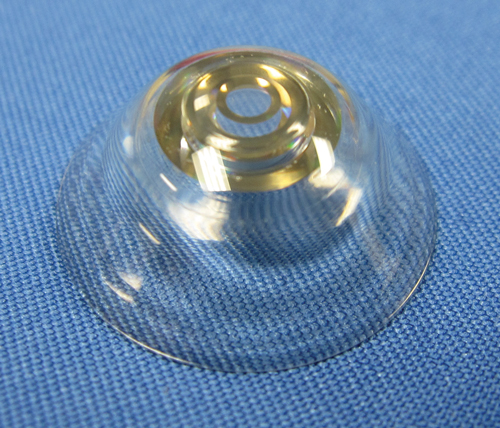
| |
|
|
The rings of concentric metal circles in this scleral lens could give AMD patients a more subtle way to enhance their vision. |
A telescopic scleral contact lens design—unveiled at the recent American Association for the Advancement of Science annual meeting in San Jose, Calif.—could one day improve the vision of patients suffering from age-related macular degeneration (AMD). Currently, bioptic telescopes mounted through spectacle lenses are the most-commonly commercially available visual aid; however, many visually impaired people reject them due to negative cosmetic and social associations.1 An intraocular miniature telescope was recently released but its permanence makes the decision to implant a difficult choice.
Initially discussed in the June 2013 Optics Express, the telescopic scleral lenses incorporate a concentric pattern of circular aluminum reflectors. When light hits these “mirrors,” a telescopic effect is achieved that enlarges objects to 2.8 times their actual size.1
Early versions of the telescopic lenses were made from PMMA, a hard, oxygen-impermeable plastic that prevented them from being worn for long periods of time. The newer design includes tiny 0.1mm air channels cut into a gas permeable plastic to help improve oxygen transmission to the cornea.1
To function, the telescopic contact lenses must be paired with a pair of modified glasses originally made for viewing 3D television. The liquid crystals contained within the glasses block either the magnifying portion of the contact lens or its unmagnified center by electrically changing the orientation of polarized light.2 The user controls this switch by winking their right eye for magnification, and their left one for normal vision; a small light source and light detector in the glasses distinguish these intentional winks from simple blinks.3
The contact lenses have already proved successful in computer simulations and when placed on an optomechanical eye constructed for testing purposes.1 Researchers hope to begin human clinical trials in the near future.
1. Tremblay EJ, Stamenov I, Beer RD, et al. Switchable telescopic contact lens. Optics Express 2013;21(13):15980-6. 2. The Optical Society. A Telescope For Your Eye: New Contact Lens Design May Improve Sight of Patients with Macular Degeneration. Available at: www.osa.org/en-us/about_osa/newsroom/news_releases/2013/a_telescope_for_your_eye_new_contact_lens_design_m. Accessed February 20, 2015. 3. Ecole polytechnique fédérale de Lausanne (EPFL). See Here Now: Telescopic Contact Lenses and Wink-Control Glasses. Available at: https://documents.epfl.ch/groups/e/ep/epflmedia/www/20150213_AAASContactLenses/2015AAAS_Tremblay_pressrelease.pdf. Accessed February 20, 2015.


